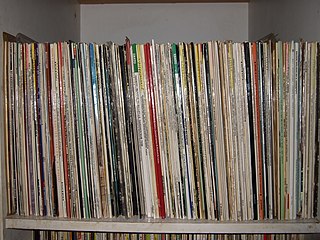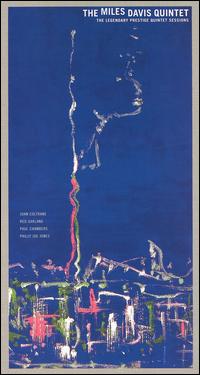Related Research Articles

Digital Audio Tape is a signal recording and playback medium developed by Sony and introduced in 1987. In appearance it is similar to a Compact Cassette, using 3.81 mm / 0.15" magnetic tape enclosed in a protective shell, but is roughly half the size at 73 mm × 54 mm × 10.5 mm. The recording is digital rather than analog. DAT can record at sampling rates equal to, as well as higher and lower than a CD at 16 bits quantization. If a comparable digital source is copied without returning to the analogue domain, then the DAT will produce an exact clone, unlike other digital media such as Digital Compact Cassette or non-Hi-MD MiniDisc, both of which use a lossy data-reduction system.

An audio tape recorder, also known as a tape deck, tape player or tape machine or simply a tape recorder, is a sound recording and reproduction device that records and plays back sounds usually using magnetic tape for storage. In its present-day form, it records a fluctuating signal by moving the tape across a tape head that polarizes the magnetic domains in the tape in proportion to the audio signal. Tape-recording devices include the reel-to-reel tape deck and the cassette deck, which uses a cassette for storage.
RCA Records is an American record label owned by Sony Music Entertainment, a subsidiary of Sony Corporation of America.

Reel-to-reel audio tape recording, also called open-reel recording, is magnetic tape audio recording in which the recording tape is spooled between reels. To prepare for use, the supply reel containing the tape is placed on a spindle or hub. The end of the tape is manually pulled from the reel, threaded through mechanical guides and over a tape head assembly, and attached by friction to the hub of the second, initially empty takeup reel. Reel-to-reel systems use tape that is 1⁄4, 1⁄2, 1, or 2 inches wide, which normally moves at 3+3⁄4, 7+1⁄2, 15 or 30 inches per second. Domestic consumer machines almost always used 1⁄4 inch (6.35 mm) or narrower tape and many offered slower speeds such as 1+7⁄8 inches per second (4.762 cm/s). All standard tape speeds are derived as a binary submultiple of 30 inches per second.

Mercury Records is an American record label owned by Universal Music Group. It had significant success as an independent operation in the 1940s and 1950s. Smash Records and Fontana Records were sub labels of Mercury. Mercury Records released rock, funk, R&B, doo wop, soul music, blues, pop, rock and roll, and jazz records. In the United States, it is operated through Republic Records; in the United Kingdom and Japan, it is distributed by EMI Records.

dbx is a family of noise reduction systems developed by the company of the same name. The most common implementations are dbx Type I and dbx Type II for analog tape recording and, less commonly, vinyl LPs. A separate implementation, known as dbx-TV, is part of the MTS system used to provide stereo sound to North American and certain other TV systems. The company, dbx, Inc., was also involved with Dynamic Noise Reduction (DNR) systems.

U-matic or 3⁄4-inch Type E Helical Scan or SMPTE E is an analogue recording videocassette format first shown by Sony in prototype in October 1969, and introduced to the market in September 1971. It was among the first video formats to contain the videotape inside a cassette, as opposed to the various reel-to-reel or open-reel formats of the time. The videotape is 3⁄4 in (19 mm) wide, so the format is often known as "three-quarter-inch" or simply "three-quarter", compared to open reel videotape formats in use, such as 1 in (25 mm) type C videotape and 2 in (51 mm) quadruplex videotape.

The Beatles' Story is the sixth album by the English rock band the Beatles in the United States, issued on 23 November 1964 by Capitol Records. It is a documentary double album featuring interviews, press conferences, and snippets of original or orchestral versions of Beatles songs, with voice-over narration. The album's original liner notes described it as a "narrative and musical biography" of Beatlemania. It was produced by Los Angeles–based songwriter and producer Gary Usher and disc jockey and lyricist Roger Christian, and narrated by John Babcock, Al Wiman and Christian.

A bootleg recording is an audio or video recording of a performance not officially released by the artist or under other legal authority. Making and distributing such recordings is known as bootlegging. Recordings may be copied and traded among fans without financial exchange, but some bootleggers have sold recordings for profit, sometimes by adding professional-quality sound engineering and packaging to the raw material. Bootlegs usually consist of unreleased studio recordings, live performances or interviews without the quality control of official releases.

Record collecting is the hobby of collecting sound recordings, usually of music, but sometimes poetry, reading, historical speeches, and ambient noises. Although the typical focus is on vinyl records, all formats of recorded music can be collected.

Deserter's Songs is the fourth studio album by American rock band Mercury Rev, released in late September 1998. British music magazine NME named Deserter's Songs album of the year for 1998. Limited edition copies of the album came in a brown cardboard envelope-like package, with a stamp on the cover postmarked with the release date, as well as two art postcards.
The history of sound recording - which has progressed in waves, driven by the invention and commercial introduction of new technologies — can be roughly divided into four main periods:
Peter Joseph Moore was a Canadian music producer who was first recognized for his innovative recordings of the Cowboy Junkies, produced on a shoestring budget.

Cartrivision is an analog videocassette format introduced in 1972, and the first format to offer feature films for consumer rental.

The LP is an analog sound storage medium, a phonograph record format characterized by: a speed of 33+1⁄3 rpm; a 12- or 10-inch diameter; use of the "microgroove" groove specification; and a vinyl composition disk. Introduced by Columbia Records in 1948, it was soon adopted as a new standard by the entire US record industry. Apart from a few relatively minor refinements and the important later addition of stereophonic sound in 1957, it remained the standard format for record albums, during a period in popular music known as the album era. Beginning in the late 1970s, LP sales began to decline due to the increasing popularity of cassette tapes and compact discs (CDs). By 1988, the latter format began to outsell LPs.

Benedict Roger Wallers, also known as The Rebel, is the frontman, guitarist, vocalist and songwriter for the band Country Teasers. His lyrics often deal with taboo subjects such as racism, sexism and xenophobia from first-person standpoints.

A mixtape is a compilation of music, typically from multiple sources, recorded onto a medium. With origins in the 1980s, the term normally describes a homemade compilation of music onto a cassette tape, CD, or digital playlist. The songs are either ordered sequentially or made into a continuous programme by beatmatching the songs and creating seamless transitions at their beginnings and endings with fades or abrupt edits. Essayist Geoffrey O'Brien described this definition of the mixtape as "perhaps the most widely practiced American art form".

The Legendary Prestige Quintet Sessions is a four compact disc box set of recordings by the Miles Davis Quintet released in 2006 by the Concord Music Group. It collates on three discs the entire set of recordings that made up the Prestige Records albums released from 1956 through 1961 — Miles, Cookin', Relaxin', Workin', and Steamin'. The track "'Round Midnight" was released on the album Miles Davis and the Modern Jazz Giants. The fourth disc contains live material from a television broadcast and in jazz club settings. It peaked at #15 on the Billboard jazz album chart, and was reissued on December 2, 2016, in a smaller compact disc brick packaging.
The BBC Transcription Services started life in the mid-1930s as the London Transcription Service to license BBC Radio programmes to overseas broadcasters who were authorised to broadcast the programmes for a set period, usually two or three years. The programmes sold to overseas broadcasters in this way covered every part of the BBC's output, including all types of music, drama, religious and children's programmes and comedy. It is now called BBC Radio International.
Matthew "Mat" Taylor, better known by his YouTube handle Techmoan, is a British YouTuber and blogger, specializing in consumer tech reviews and retrotech documentaries about technology of historical interest.
References
- ↑ "Video Yesteryear, Inc". OpenCorporates. n.d. Archived from the original on April 26, 2024.
- 1 2 3 4 Moses, Nancy (2015). Stolen, Smuggled, Sold: On the Hunt for Cultural Treasures. Rowman & Littlefield. ISBN 9780759121942 – via Google Books.
- 1 2 3 Kemper, Steve (June 19, 1994). "Conversations: Reminiscing through recordings". The Hartford Courant: 4 – via Newspapers.com.
- ↑ Birdsall, Carolyn (2023). Radiophilia. Bloomsbury Publishing. p. 182. ISBN 9781501374982 – via Google Books.
- 1 2 3 Angus, Robert (April 1974). "Old-Time Radio Is Alive and Well in a Croton-on-Hudson Garage" (PDF). High Fidelity and Musical America. 24 (4). Billboard Publications: 59–63 – via World Radio History.
- 1 2 Anonymous (n.d.). "Goldin, J. David". Special Collections and Archives Finding Aids. UMKC University Libraries. Archived from the original on June 8, 2023.
- 1 2 3 4 Wilber, Del Quentin; Lisa Rein (May 3, 2012). "The sleuth, the Babe and a radio mystery". The Washington Post: A1 – via ProQuest.
- ↑ Sterling, Christopher H., ed. (2010). The Concise Encyclopedia of American Radio. Taylor & Francis. p. 470. ISBN 9781135176846 – via Google Books.
- ↑ Frederick, R. D. "Gus"; Whitty, Jim M. (n.d.). "Re-Recordings & Reissues: Your Source for New Old Music!". Wolverine Antique Music Society.
- 1 2 Nichols, Peter (April 8, 1990). "Fast Forward: A Matter of Entrances and Exits". The New York Times: A32 – via ProQuest.
- ↑ Feder, Robert (December 16, 1998). "Channel 2 profits from ad that looks like news". Chicago Sun-Times: 55 – via ProQuest.